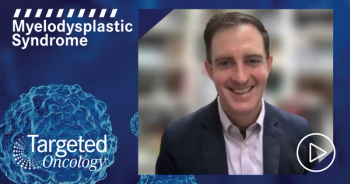
Looking Back at CheckMate 649 in GI Cancer and the FDA Discussion on PD-L1 Level
In interviews with Targeted Oncology, Ronan J. Kelly, MD, MBA, and David Zhen, MD, discuss the CheckMate 649 trial of nivolumab plus ipilimumab and look back on last year's ODAC meeting on its use in PD-L1–negative gastrointestinal cancers.
Ronan J. Kelly, MD, MBA, director of oncology at the Charles A. Sammons Cancer Center at Baylor University Medical Center in Dallas, Texas, and the chief of oncology for the Baylor, Scott, and White Health System in North Texas; and David B. Zhen, MD, associate professor in the clinical research division of Fred Hutchinson Cancer Center, discussed the impacts of the CheckMate 649 trial with 4-year follow-up and look back on the
TRANSCRIPTION:
0:05 | KELLY: CheckMate 649 came in 2021. This was a multicenter, randomized, open label phase 3 trial. It was done in 175 hospitals across 29 countries, and it was published originally in 2021, but now we have 4 years of follow-up information so we can talk about that. But the original manuscript was in The Lancet, and then we've seen other publications in recent years.
KELLY: If you look now at 4 years of information, we're looking at a minimum follow-up of about 48 months, we now see a median overall survival improvement [for] all comers, of 13.7 months vs 11.6 months. If you take the 60% or so of all patients that would have a PD-L1 combined positive score greater than 5, there is an improved efficacy there meeting overall survival of 14.4 months vs 11.1 months, that's a hazard ratio of 0.7.
ZHEN: While the primary endpoint here was looking at patients with PD-L1 of CPS 5 or above, it is noteworthy that in the trial that there was noted a survival benefit in all patients, regardless of PD-L1. There’s been a lot of debate about what CPS cut offs we should be using, and in late 2024 the FDA had convened because of the confusion over the PD-L1 cutoffs.
KELLY: We know that PD-L1, as you select patients for expression, we can see an improvement. But there is an FDA all-comers approval, which may change a little bit though, based on a recent FDA ODAC meeting, which happened in September, where they highlighted that the majority of the benefits were occurring in the 80% or so that had PD-L1 CPS score greater than 1. We anticipate that there may be a change in the labeling there. We'll have to wait and see. But that was the discussion at the FDA ODAC meeting.
KELLY: If you look back and look at the 4-year survival rates, what we're seeing is a difference of 9% between those that were treated with nivolumab at greater than CPS of 5 at 17% alive at 4 years vs 8% in those that were treated with chemotherapy alone. So that's a substantial improvement over where we've been. The 4-year survival data in the all-comer population, the delta is approximately 5% in terms of 5-year survival rates.
ZHEN: I think where we may be heading down the road is that we may be looking at more PD-L1 as more of a positive or negative result, and the reason being is because that's where the confidence lie in pathology reads. But also what we're seeing in studies is that when it's truly negative, we are seeing much less of a benefit. In other words, in terms of clinical practice, even though 5 and above does confer greater benefit, some patients who are at least still positive might still drive some benefits.
This video includes content created with generative AI.










































